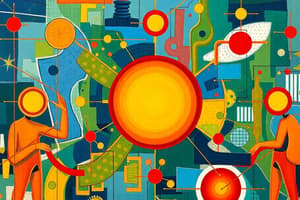Podcast
Questions and Answers
Which of the following best describes the primary function of non-mechanical systems in society?
Which of the following best describes the primary function of non-mechanical systems in society?
- To provide organizational services to society. (correct)
- To replace mechanical systems entirely.
- To operate without any human intervention.
- To utilize physical forces for energy transfer.
What is the crucial element that ensures a non-mechanical system effectively achieves its objectives?
What is the crucial element that ensures a non-mechanical system effectively achieves its objectives?
- The use of advanced technology.
- The simplicity of its design.
- The independent operation of its components.
- The organized interaction of its components. (correct)
In the context of a school system, which of the following is considered a non-mechanical component?
In the context of a school system, which of the following is considered a non-mechanical component?
- The desks and chairs.
- The curriculum and schedules. (correct)
- The building's heating system.
- The school buses.
What role do governments or organizations typically play in a non-mechanical system?
What role do governments or organizations typically play in a non-mechanical system?
In a city's transportation system, which of these elements is considered a non-mechanical component?
In a city's transportation system, which of these elements is considered a non-mechanical component?
What is the primary reason for monitoring a non-mechanical system after it has been implemented?
What is the primary reason for monitoring a non-mechanical system after it has been implemented?
What is a common method for providing support and information for a new non-mechanical system, such as a new computer system?
What is a common method for providing support and information for a new non-mechanical system, such as a new computer system?
What is the significance of the Canadian Standards Association (CSA) in the context of societal systems?
What is the significance of the Canadian Standards Association (CSA) in the context of societal systems?
How does increased productivity typically impact the number of jobs available?
How does increased productivity typically impact the number of jobs available?
What is one potential drawback of mass production?
What is one potential drawback of mass production?
What is the primary role of automation in systems?
What is the primary role of automation in systems?
Which of the following is an example of an environmental impact of automation?
Which of the following is an example of an environmental impact of automation?
How does automating pollution control systems in cars positively affect the environment?
How does automating pollution control systems in cars positively affect the environment?
What should be considered when forming an opinion about automation?
What should be considered when forming an opinion about automation?
What is the purpose of evaluating a system?
What is the purpose of evaluating a system?
Which of the following is an example of a quantitative evaluation of a system?
Which of the following is an example of a quantitative evaluation of a system?
Which of the following reflects a qualitative assessment?
Which of the following reflects a qualitative assessment?
What was a primary disadvantage of early containers used to transport food?
What was a primary disadvantage of early containers used to transport food?
Why were paper bags introduced as a replacement for traditional methods of transporting food?
Why were paper bags introduced as a replacement for traditional methods of transporting food?
What is a known risk associated with plastic bags?
What is a known risk associated with plastic bags?
Flashcards
System Components
System Components
Components of a system that work together to complete a task.
School System
School System
A school is a non-mechanical system comprising students, staff, books, and schedules.
Non-Mechanical Systems
Non-Mechanical Systems
An organizational system that provides a service to society.
System Organization
System Organization
Signup and view all the flashcards
Transportation System
Transportation System
Signup and view all the flashcards
Canadian Standards Association (CSA)
Canadian Standards Association (CSA)
Signup and view all the flashcards
System Effectiveness
System Effectiveness
Signup and view all the flashcards
Productivity
Productivity
Signup and view all the flashcards
Augmenting Productivity
Augmenting Productivity
Signup and view all the flashcards
Automated Systems
Automated Systems
Signup and view all the flashcards
Mass Production
Mass Production
Signup and view all the flashcards
Automated System
Automated System
Signup and view all the flashcards
Social Effects of Automation
Social Effects of Automation
Signup and view all the flashcards
Environmental Effects of Automation
Environmental Effects of Automation
Signup and view all the flashcards
Quantitative Evaluation
Quantitative Evaluation
Signup and view all the flashcards
Qualitative Evaluation
Qualitative Evaluation
Signup and view all the flashcards
Criterion
Criterion
Signup and view all the flashcards
Ancient Food Containers
Ancient Food Containers
Signup and view all the flashcards
Plastic Bags
Plastic Bags
Signup and view all the flashcards
Reusable Shopping Bags
Reusable Shopping Bags
Signup and view all the flashcards
Study Notes
- Les composantes d'un système non mécanique fonctionnent ensemble pour exécuter une tâche.
- De nombreux systèmes non mécaniques sont conçus pour répondre aux besoins de la société.
- Des renseignements et des services de soutien sont nécessaires pour assurer le bon fonctionnement d'un système.
Systèmes non mécaniques dans la société
- Les systèmes non mécaniques comprennent un système organisationnel qui fournit un service à la société.
- Les systèmes mécaniques utilisent des forces pour accomplir le travail et transférer de l'énergie.
- Les systèmes non mécaniques exécutent des tâches sans avoir recours à des forces.
- Un système scolaire est un système non mécanique qui comprend le personnel enseignant, de direction, les concierges, le personnel administratif, les chauffeurs d'autobus, et les conseils scolaires.
- Le système scolaire comprend les livres, les bureaux, les bâtiments, les terrains de jeux, l'équipement, les matières, les horaires et les règlements.
- Pour qu'un système exécute sa tâche avec succès, ses composantes doivent interagir, chaque composante contribuant à la réalisation de la tâche.
Systèmes et organisation
- Pour qu'un système non mécanique soit efficace, ses composantes doivent fonctionner ensemble d'une façon organisée.
- Une personne, une entreprise ou un gouvernement coordonne les composantes d'un système.
- Un système de transport comprend des systèmes mécaniques (autobus, trains, métros) et non mécaniques (chauffeurs, itinéraires, horaires).
- Les composantes doivent fonctionner ensemble pour assurer un transport efficace et sécuritaire.
Systèmes et besoins
- Les systèmes non mécaniques naissent d'un besoin de la société.
- Un système de soins aux enfants est né du besoin des familles où les deux parents travaillent.
- Un système doit être surveillé et évalué pour s'assurer qu'il répond aux besoins de ses consommateurs.
- Un système doit fournir des renseignements et services de soutien aux utilisateurs.
- Les systèmes comprennent un service de soutien pour résoudre les problèmes.
Productivité
- Augmenter la productivité permet d'accomplir une tâche plus rapidement ou d'accomplir un plus grand nombre de tâches en même temps.
- Faire des achats par Internet permet de gagner du temps.
- Les systèmes bien conçus augmentent la productivité.
- Une combinaison de systèmes mécaniques et non mécaniques augmente souvent la productivité.
Automatisation
- Un système automatisé remplace les humains par des machines fonctionnant sans intervention humaine.
- L'automatisation a eu un effet sur notre société, l'environnement et l'économie.
- La production de masse est un système où chaque employé effectue une petite tâche répétitive sur une chaîne de montage, produisant des articles identiques rapidement et à moindre coût.
- Les biens fabriqués sur une chaîne de montage automatisée sont souvent de moins bonne qualité que les biens fabriqués à la main.
- Un système automatisé effectue le travail au moyen de machines contrôlées par ordinateur.
- L'automatisation sert à exécuter des tâches simples ou complexes.
Effet de l'automatisation et évaluation
- L'automatisation a des effets sociaux, économiques et environnementaux.
- Socialement, de nombreux emplois traditionnels sont remplacés par des systèmes automatisés, mais de nouveaux emplois sont créés.
- Économiquement, l'automatisation augmente généralement la productivité et peut réduire les coûts, mais diminue le nombre d'employés requis.
- Environnementalement, l'automatisation peut augmenter la consommation d'énergie, mais peut aussi réduire les émissions nocives.
- Il faut évaluer l'effet d'un changement de système sur les gens, la société et l'environnement.
- Les critères d'évaluation d'un système sont le rendement, la sécurité, le coût et l'effet sur l'environnement.
- Une évaluation peut être quantitative (analyse de données chiffrées) ou qualitative (analyse basée sur l'observation).
Systèmes de transport des aliments
- Il y a des milliers d'années, les contenants pour transporter la nourriture étaient faits de feuillages, de branches tressées, de peaux d'animaux, d'argile et d'organes d'animaux.
- Ces contenants étaient peu performants, peu sécuritaires et peu coûteux, avec un faible impact environnemental.
- Les premiers sacs en papier ont rapidement remplacé les méthodes traditionnelles de transport de la nourriture.
- Les sacs en papier ont un coût de production élevé et sont peu solides, mais sont biodégradables.
- Les sacs en plastique ont remplacé les sacs en papier à partir de la fin des années 1970.
- Ils sont moins coûteux à fabriquer, réutilisables et résistants, mais mettent beaucoup de temps à se décomposer.
- Les sacs en plastique peuvent présenter des risques pour la sécurité et l'environnement.
- Plusieurs personnes utilisent des sacs réutilisables pour transporter leur nourriture.
Studying That Suits You
Use AI to generate personalized quizzes and flashcards to suit your learning preferences.




